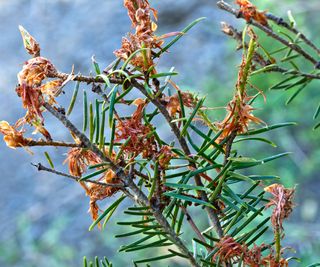Douglas fir (Pseudotsuga menziesii) are beautiful evergreen trees native to the Pacific Northwest and parts of the Rocky Mountains. They are tall, elegant trees that support native wildlife, act as windbreaks, and help control erosion. Unfortunately, they have a serious pest, the Douglas fir tussock moth. They feed on the needles of Douglas Fir and tend to occur in areas where outbreaks occur. They are often a bigger problem in drought conditions. We explain how to tell if your plants are infected, how to treat outbreaks, and how to prevent them.
Identifying a Douglas Fir Tussock Moth
It is the caterpillars, not the moths, that feed on and destroy fir trees. Here are some identifying characteristics of the Douglas fir tussock caterpillar:
- Approximately 1.25 inches (3.2 cm) long.
- Grayish brown body and shiny black head.
- Black tufts of fur – two in front and one in back.
- Short brown hairs grow out of red spots.
Spotting caterpillars is the easiest way to identify this pest, but you can also spot other stages of the Douglas fir tussock moth life cycle:
- Females lay round, white eggs in a frothy substance.
- The cocoons cling to tree branches, are greyish-brown in colour and appear hairy.
- Adult female moths are wingless and have thick bodies.
- Male moths fly and have reddish-brown forewings and grayish-brown hindwings. They are about an inch (2.5 cm) wide.
Signs of Douglas Fir Tussock Moth Damage
Tussock moth caterpillars begin feeding on new growth at the top of the plant. Visible damage appears at the top and spreads down the plant. This feeding leads to shedding of affected areas of the plant. In severe outbreaks, feeding and damage can occur throughout the entire plant.

(Image credit: Inga Spence / Alamy)
The Risk of Having Douglas Fir Tussock Moths
As tussock moths feed on Douglas fir trees, they damage the needles, causing them to fall off the tree. They often kill the tops of trees this way if left unchecked. Severe damage can kill entire trees, especially if infestations go unchecked for more than one season.
Needle loss due to tussock moths also leaves Douglas fir trees susceptible to other problems, including bark beetlecanker and canker. Although native to Douglas fir, these pests can cause a lot of damage during outbreaks.
Treating Douglas Fir Tussock Moth Infestation
There are natural controls for Douglas fir tussock moths in native environments. Parasitic waspTachinid flies, spiders, and birds all eat caterpillars. Birds eat caterpillars heavily when they are young, before they develop their annoying spines.
A basic Douglas fir moth prevention strategy is to promote other native species. Plant native plants supports the caterpillars’ natural predators, helping to prevent or minimize outbreaks. Since periodic outbreaks are normal, your Douglas fir tree will likely not suffer significant damage unless it is stressed. If you see signs of an infestation, provide water and fertilizer to reduce stress.
If you have a large infestation, you can use a safe pesticide. Most effective pesticides These are not available to the public, but you can find a number of chemical and biological pesticides labeled for tussock moths that may help reduce their numbers. Since the moths often stay in the treetops, it is best to hire a professional to do the spraying.

(Image credit: Angle / Alamy)
frequently asked Questions
Are Douglas Fir Tussock Moths Poisonous?
Douglas fir tussock caterpillars are not poisonous. However, like other tussock caterpillars, they carry toxins in their spines that cause a rash on contact. Some people are more severely affected than others.
What is the most poisonous moth in the world?
More poisonous than tussock moths are members of the genus Lonomia from South America. The caterpillars have poisonous spines with poison that can be fatal. Their poison causes internal bleeding. Serious injury or death usually only occurs when someone comes into contact with a lot of Lonomia caterpillar.
